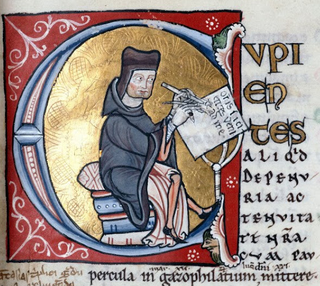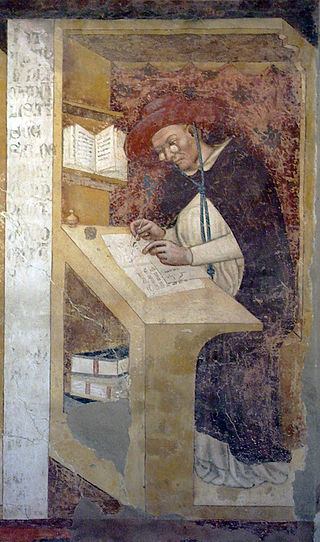
The Collectanea, or Magna glossatura as it came to be known, is a collection of commentaries on the Psalms and the Pauline Epistles written by Peter the Lombard between 1139 and 1141.

The Collectanea, or Magna glossatura as it came to be known, is a collection of commentaries on the Psalms and the Pauline Epistles written by Peter the Lombard between 1139 and 1141.
The Magna glossatura is a set of glosses written beside passages from the Latin Vulgate Bible. These glosses were written by Peter the Lombard during his teaching career and before he became the bishop of Paris (1159–1160). His gloss of Psalms and his gloss of the Pauline Epistles (referred to as the Collectanea) were compiled and became a part of the official gloss on the Bible. [1] This collection of glosses would take on the name of Magna glossatura and would, during the 12th century, replace the Glossa ordinaria as the most frequently studied and copied exegetical gloss of the Bible. [2] His other works included the Libri Quatuor Sententiarum (or the Four Books of Sentences ) and his commentaries in the glossa Ordinaria. The Magna glossatura, along with other systematic glosses, would have been developed at theological schools such as Laon and Saint-Victor of Paris, and would have been used for the research conducted by theologians as well as the teaching of students in biblical exegesis. [3]
The layout of text in the Magna glossatura, is written in the intercisum (or intercut) format, which was developed by Peter Lombard. [4] It was developed as a way of distinguishing scripture from the commentaries by writing the biblical verses in a larger script and on alternate lines next to the commentary, which would be ordered into columns. Blocks of scripture were then placed on the left edge of the columns to balance the biblical verses with the commentary. [5] The intercisum method, from ca.1160, began to be applied to glosses on all the books of the Bible. [6] This layout also gave glosses and their commentators greater influence in their relationship with the Word of God, as these glosses played a larger role in theological books by forming an essential reading in connection with the biblical text. [7]
Peter Lombard's gloss of the Pauline Epistles features not only commentaries concerning the traditional mode of reflection on the Christian faith, which regards the biblical text as sacra pagina, but also commentaries of systematic theology. [8] As a result, Lombard writes on specific theological themes which deal with issues such as the nature of the Trinity. Lombard's glosses also include references to the works of other ecclesiastical figures and theologians, Ambrose and Augustine to name a few. The biblical commentaries and ideas present in the Magna glossatura are also present in the various sermons given by Peter Lombard to his peers and to his cathedral's congregation. [9]

The Epistle to the Ephesians is the tenth book of the New Testament. According to its text, the letter was written by Paul the Apostle, an attribution that Christians traditionally accepted. However, starting in 1792, some scholars have claimed the letter is actually Deutero-Pauline, meaning that it is pseudepigrapha written in Paul's name by a later author strongly influenced by Paul's thought. According to one scholarly source, the letter was probably written "by a loyal disciple to sum up Paul's teaching and to apply it to a new situation fifteen to twenty-five years after the Apostle's death".

The Epistle to the Colossians is the twelfth book of the New Testament. It was written, according to the text, by Paul the Apostle and Timothy, and addressed to the church in Colossae, a small Phrygian city near Laodicea and approximately 100 miles (160 km) from Ephesus in Asia Minor.

The Epistle to Titus is one of the three pastoral epistles in the New Testament, historically attributed to Paul the Apostle. It is addressed to Saint Titus and describes the requirements and duties of presbyters/bishops.

2 Peter, also known as the Second Epistle of Peter and abbreviated as 2 Pet., is an epistle of the New Testament written in Koine Greek. It identifies the author as "Simon Peter", a bondservant and apostle of Jesus Christ". The epistle is traditionally attributed to Peter the Apostle, but most scholars consider the epistle pseudepigraphical Scholars estimate the date of authorship anywhere from AD 60 to 150.
Anselm of Laon, properly Ansel, was a French theologian and founder of a school of scholars who helped to pioneer biblical hermeneutics.
The oldest surviving Hebrew Bible manuscripts, the Dead Sea Scrolls, date to c. the 2nd century BCE. Some of these scrolls are presently stored at the Shrine of the Book in Jerusalem. The oldest text of the entire Christian Bible, including the New Testament, is the Codex Sinaiticus dating from the 4th century CE, with its Old Testament a copy of a Greek translation known as the Septuagint. The oldest extant manuscripts of the vocalized Masoretic Text date to the 9th century CE. With the exception of a few biblical sections in the Nevi'im, virtually no biblical text is contemporaneous with the events it describes.
Middle English Bible translations covers the age of Middle English, beginning after the Norman Conquest (1066) and ending about 1500.

The Pauline epistles, also known as Epistles of Paul or Letters of Paul, are the thirteen books of the New Testament attributed to Paul the Apostle, although the authorship of some is in dispute. Among these epistles are some of the earliest extant Christian documents. They provide an insight into the beliefs and controversies of early Christianity. As part of the canon of the New Testament, they are foundational texts for both Christian theology and ethics.

Peter Lombard was an Italian scholastic theologian, Bishop of Paris, and author of Four Books of Sentences which became the standard textbook of theology, for which he earned the accolade Magister Sententiarum.

The Four Books of Sentences is a compendium of theology written by Peter Lombard around 1150.

The pastoral epistles are a group of three books of the canonical New Testament: the First Epistle to Timothy, the Second Epistle to Timothy, and the Epistle to Titus. They are presented as letters from Paul the Apostle to Timothy and to Titus. However, many scholars believe they were written after Paul's death. They are generally discussed as a group and are given the title pastoral because they are addressed to individuals with pastoral oversight of churches and discuss issues of Christian living, doctrine and leadership. The term "pastorals" was popularized in 1703 by D. N. Berdot and in 1726 by Paul Anton. Alternate nomenclature for the cluster of three letters has been proposed: "Corpus Pastorale," meant to highlight the intentional forgery of the letters as a three-part corpus, and "Letters to Timothy and Titus," meant to emphasize the individuality of the letters.

Hugh of Saint-Cher, O.P. was a French Dominican friar who became a cardinal and noted biblical commentator.
Robert of Melun was an English scholastic Christian theologian who taught in France, and later became Bishop of Hereford in England. He studied under Peter Abelard in Paris before teaching there and at Melun, which gave him his surname. His students included John of Salisbury, Roger of Worcester, William of Tyre, and possibly Thomas Becket. Robert was involved in the Council of Reims in 1148, which condemned the teachings of Gilbert de la Porrée. Three of his theological works survive, and show him to have been strictly orthodox.

Peter Comestor was a 12th-century French theological writer and university teacher.
The Glossa Ordinaria, which is Latin for "Ordinary [i.e. in a standard form] Gloss", is a collection of biblical commentaries in the form of glosses. The glosses are drawn mostly from the Church Fathers, but the text was arranged by scholars during the twelfth century. The Gloss is called "ordinary" to distinguish it from other gloss commentaries. In origin, it is not a single coherent work, but a collection of independent commentaries which were revised over time. The Glossa ordinaria was a standard reference work into the Early Modern period, although it was supplemented by the Postills attributed to Hugh of St Cher and the commentaries of Nicholas of Lyra.
There is much disagreement within biblical scholarship today over the authorship of the Bible. The majority of scholars believe that most of the books of the Bible are the work of multiple authors and that all have been edited to produce the works known today. The following article outlines the conclusions of the majority of contemporary scholars, along with the traditional views, both Jewish and Christian.
In Biblical studies, a gloss or glossa is an annotation written on margins or within the text of biblical manuscripts or printed editions of the scriptures. With regard to the Hebrew texts, the glosses chiefly contained explanations of purely verbal difficulties of the text; some of these glosses are of importance for the correct reading or understanding of the original Hebrew, while nearly all have contributed to its uniform transmission since the 11th century. Later on, Christian glosses also contained scriptural commentaries; St. Jerome extensively used glosses in the process of translation of the Latin Vulgate Bible.
Pheme Perkins is a Professor of Theology at Boston College, where she has been teaching since 1972.

Romans 1 is the first chapter of the Epistle to the Romans in the New Testament of the Christian Bible. It is authored by Paul the Apostle, while he was in Corinth in the mid-50s AD, with the help of an amanuensis (secretary), Tertius, who adds his own greeting in Romans 16:22. Acts 20:3 records that Paul stayed in Greece, probably Corinth, for three months. The letter is addressed "to all in Rome who are loved by God and called to be saints".

Philipp W. Rosemann is a German philosopher and Cottrill-Rolfes Chair at University of Kentucky. Previously he was Professor of Philosophy at Maynooth University. He is the co-editor of Dallas Medieval Texts and Translations. Prior to his tenure at Maynooth, he taught at the University of Dallas for twenty years.